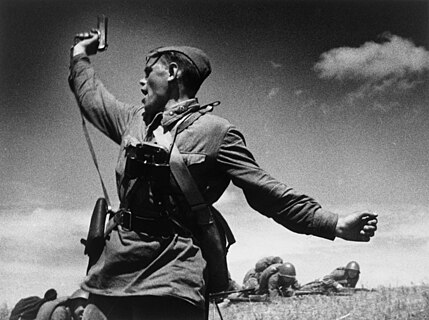Commons:Featured picture candidates/File:RIAN archive 543 A battalion commander.jpg
Jump to navigation
Jump to search
File:RIAN archive 543 A battalion commander.jpg, not featured
[edit]Voting period is over. Please don't add any new votes.Voting period ends on 14 Apr 2021 at 13:45:54 (UTC)
Visit the nomination page to add or modify image notes.
- Gallery: Commons:Featured pictures/Historical#1940-1950
 Info created by Max Alpert - uploaded by RIANbot - retouched by Hohum - nominated by TheFreeWorld -- TheFreeWorld (talk) 13:45, 5 April 2021 (UTC)
Info created by Max Alpert - uploaded by RIANbot - retouched by Hohum - nominated by TheFreeWorld -- TheFreeWorld (talk) 13:45, 5 April 2021 (UTC) Support -- TheFreeWorld (talk) 13:45, 5 April 2021 (UTC)
Support -- TheFreeWorld (talk) 13:45, 5 April 2021 (UTC) Weak oppose would benefit from denoising, certainly denoising the sky. Buidhe (talk) 07:33, 6 April 2021 (UTC)
Weak oppose would benefit from denoising, certainly denoising the sky. Buidhe (talk) 07:33, 6 April 2021 (UTC) Oppose per above --Andrei (talk) 08:30, 6 April 2021 (UTC)
Oppose per above --Andrei (talk) 08:30, 6 April 2021 (UTC)
 Disagree That's film grain and thus integral part of the image – a faithful digital representation of the historical analog original needs to include this. Removing film grain would be somewhat equivalent to retouching visible brush strokes in a painting … --El Grafo (talk) 09:26, 6 April 2021 (UTC)
Disagree That's film grain and thus integral part of the image – a faithful digital representation of the historical analog original needs to include this. Removing film grain would be somewhat equivalent to retouching visible brush strokes in a painting … --El Grafo (talk) 09:26, 6 April 2021 (UTC)
 Support Isn't this an iconic picture? Daniel Case (talk) 18:59, 7 April 2021 (UTC)
Support Isn't this an iconic picture? Daniel Case (talk) 18:59, 7 April 2021 (UTC) Oppose Not sure if it's iconic or not, but in any case no wow for me. Very bad quality with strong noise, and the worse part is certainly the darkness of the sky -- Basile Morin (talk) 00:07, 8 April 2021 (UTC)
Oppose Not sure if it's iconic or not, but in any case no wow for me. Very bad quality with strong noise, and the worse part is certainly the darkness of the sky -- Basile Morin (talk) 00:07, 8 April 2021 (UTC) Support This is a new version of already existing FP. Great picture, keeping in mind the time it was taken and the circumstances. --Maksim Sokolov (talk). 01:00, 8 April 2021 (UTC)
Support This is a new version of already existing FP. Great picture, keeping in mind the time it was taken and the circumstances. --Maksim Sokolov (talk). 01:00, 8 April 2021 (UTC) Support: this is one of the most recognized Soviet WWII photos. The subject was killed within minutes of being photographed - to keep (normally valid) concerns about the technical quality in perspective. --The Cosmonaut (talk) 01:40, 8 April 2021 (UTC)
Support: this is one of the most recognized Soviet WWII photos. The subject was killed within minutes of being photographed - to keep (normally valid) concerns about the technical quality in perspective. --The Cosmonaut (talk) 01:40, 8 April 2021 (UTC)
 Comment More details about this photograph here --Maksim Sokolov (talk). 03:04, 8 April 2021 (UTC)
Comment More details about this photograph here --Maksim Sokolov (talk). 03:04, 8 April 2021 (UTC)
 Support per Maksimsokolov, provided that a link to the Wikipedia article or other relevant documentation of the facts he mentions is provided in the file description in every language. Thanks for the context. -- Ikan Kekek (talk) 06:02, 8 April 2021 (UTC)
Support per Maksimsokolov, provided that a link to the Wikipedia article or other relevant documentation of the facts he mentions is provided in the file description in every language. Thanks for the context. -- Ikan Kekek (talk) 06:02, 8 April 2021 (UTC) Oppose very poor quality and strong vignetting. --Ivar (talk) 07:37, 8 April 2021 (UTC)
Oppose very poor quality and strong vignetting. --Ivar (talk) 07:37, 8 April 2021 (UTC) Oppose Per Ivar RolfHill (talk) 18:08, 8 April 2021 (UTC)
Oppose Per Ivar RolfHill (talk) 18:08, 8 April 2021 (UTC)
Extended content
|
|---|
|
 Support For an iconic photo like this, the discussion we should be having is which version we should promote. The educational value, importance, and wow are all build-in sufficient to cover any technical shortcomings. I'm also kind of aghast at the examples Cart mentions above. Sigh... — Rhododendrites talk | 13:50, 9 April 2021 (UTC)
Support For an iconic photo like this, the discussion we should be having is which version we should promote. The educational value, importance, and wow are all build-in sufficient to cover any technical shortcomings. I'm also kind of aghast at the examples Cart mentions above. Sigh... — Rhododendrites talk | 13:50, 9 April 2021 (UTC)
- Adding to your misery, even Pale Blue Dot (the hardest photo ever to take so far) got chewed up here. Twice. --Cart (talk) 15:52, 9 April 2021 (UTC)
- So then I have to ask, cart, what keeps you from voting? — Rhododendrites talk | 16:25, 9 April 2021 (UTC)
- @Rhododendrites: This. I don't vote on other people's nominations anymore since I can't trust my damaged eyes any longer. It's difficult to decide were to draw the line, so it's better to not do it. --Cart (talk) 16:42, 9 April 2021 (UTC)
Extended content
|
|---|
|
 Support --Yann (talk) 20:22, 10 April 2021 (UTC)
Support --Yann (talk) 20:22, 10 April 2021 (UTC)
Confirmed results:
